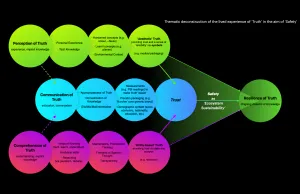DRAFT CONTENT 🚧
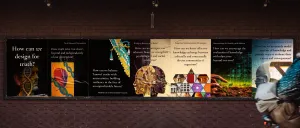
In our digitally interconnected world, misinformation spreads faster than ever: adding noise and confusion to the public discourse.
- False news travels six times faster on Twitter than the truth1.
- In 2020, UNESCO stated that we're experiencing an 'infodemic'2: where an overabundance of information, often false or misleading, accompanies every major event: sowing seeds of confusion, fear and mistrust.
This chaotic information landscape, at times, suggests we are drifting towards a 'post-truth' era, where objective facts are less influential in shaping public opinion than persuasively-designed appeals to our emotions or personal beliefs. This is particularly salient in the context of COVID-19, where misinformation and conspiracies run rife.
This two week research project provided an overview of Design for Truth as a wicked problem to inform creative problem solving by the 400+ postgraduate designers taking part in the RCA x Logitech Grand Challenge 2021: Design for Safety.
Wicked problems are deeply complex, multifaceted issues with no definitive solutions. They can only be addressed by strategic approaches which involve some non-empirical judgments and are therefore inherently normative and value-based3. These approaches can't be 'right' or 'wrong' in a conventional sense; but they can be more or less acceptable or effective based on the values and objectives of those affected.
We aimed to demistify the complex, multi-dimensional concept of Truth by mapping and breaking down its key attributes. This framework was intended to reduce the paralysing sense of uncertainty that can accompany complex problem areas, whilst providing an open-ended introduction to the problem: one that encouraged the designers’ own, organic directions and value judgments to emerge.
How can we design for truth and the safety of individuals and society?
🔍
Grappling with Truth's Complexity
The Etymology of Truth
We began by exploring the etymology of Truth, which is rooted in ideas of faithfulness and constancy.
Truth has been identified as a measure of any theory's ability to accurately represent the world (constancy) under a limited number of assumptions (faithfulness) (see 1).
- This led us to use ‘Sense of Objective Certainty’ as a lens to blend these key attributes, forming the x-axis of our map.
Evaluating Truth
Whether truth exists externally to us or not, we only have access to it through our own experience. Given this phenomenological perspective, and the 'wicked' nature of designing for truth, we recognised that its design necessarily involves normative value judgments and some 'nonempirical criteria' in order to evaluate the appropriateness of any design strategy.
We decided to adopt an ecological perspective upon the purpose and evaluation of Truth, due to:
- The wider context of the Grand Challenge (design for ‘safety’ or freedom from harm).
- The fact that the experience of Truth (as a phenomenological value judgment) is contingent on the continuation of life.
- Our own sense of the purpose of Truth.
-
We therefore identified 'Ecosystem Health'
as a key measure of Truth, forming the
y-axis of our map.
A Systemic Perspective on the Construction of Truth
Having identified these criteria and set the bounds of our enquiry, we were able to map different elements of Truth across multiple domains.
In order of decreasing complexity (and increasing 'Sense of Objective Certainty'), these domains are the:
- Cultural
- Biological
- Physical
- Metaphysical
🔍
The Cultural Domain as a Key Intervention Area
From this deconstruction, the cultural domain emerged as a key intervention area for designers: where they can intervene to promote different modes of disseminating and amplifying information in society, as well as to influence degrees of certainty in that information.
We recognised that this is where designers can intervene to shift modes of debate and mindsets, selecting different strategies to suit the existing socio-technical regimes/cultural operating systems.
Leverage Points at the Individual, Biological Level
Going into a finer view of the individual mechanisms at work, we identified 3 key pathways by which Truth is evaluated:
-
The Æsthetics of Truth
Our visceral, sensory/perceptual response -
The Comprehension of Truth
Our reflective, cognitive response
Which together feed into:
-
The Communication of Truth
Our behavioural response — acting upon our sense of truth
By comparing our sensory/perceptual and cognitive responses with our actions and conversations, we corroborate information and infer causal connections. Over time, we propose that this corroboration creates the sense of trust that enhances the resilience of information.
🔍
Encouraging Critical Perspectives
What constitutes truth, and how should it be designed?
We identified a range of open-ended questions to provoke critical reflection on different strategic, ethical approaches to Truth and its underlying mechanisms.
- Designed to stimulate a range of discussions and reflection within the 77 design teams across the grand challenge.
- Intended to express the multifaceted nature and wickedness of Design for Truth.
- Left open and ranging across the domains to encourage individual perspectives to diverge from our deconstruction and ethical assumptions/stance.
Grappling with Truth's Complexity
The Etymology of Truth
We began by exploring the etymology of Truth, which is rooted in ideas of faithfulness and constancy.
Truth has been identified as a measure of any theory's ability to accurately represent the world (constancy) under a limited number of assumptions (faithfulness) (see 1).
- This led us to use ‘Sense of Objective Certainty’ as a lens to blend these key attributes, forming the x-axis of our map.
Evaluating Truth
Whether truth exists externally to us or not, we only have access to it through our own experience. Given this phenomenological perspective, and the 'wicked' nature of designing for truth, we recognised that its design necessarily involves normative value judgments and some 'nonempirical criteria' in order to evaluate the appropriateness of any design strategy.
We decided to adopt an ecological perspective upon the purpose and evaluation of Truth, due to:
- The wider context of the Grand Challenge (design for ‘safety’ or freedom from harm).
- The fact that the experience of Truth (as a phenomenological value judgment) is contingent on the continuation of life.
- Our own sense of the purpose of Truth.
-
We therefore identified 'Ecosystem
Health' as a key measure of
Truth, forming the y-axis of our
map.
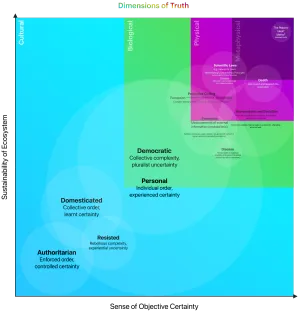
The Cultural Domain as a Key Intervention Area
From this deconstruction, the cultural domain emerged as a key intervention area for designers: where they can intervene to promote different modes of disseminating and amplifying information in society, as well as to influence degrees of certainty in that information.
We recognised that this is where designers can intervene to shift modes of debate and mindsets, selecting different strategies to suit the existing socio-technical regimes/cultural operating systems.
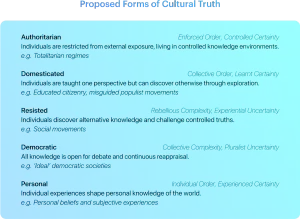
Encouraging Critical Perspectives
What constitutes Truth, and how should it be designed?
We identified a range of open-ended questions to provoke critical reflection on different strategic, ethical approaches to Truth and its underlying mechanisms.
- Designed to stimulate a range of discussions and reflection within the 77 design teams across the grand challenge.
- Intended to express the multifaceted nature and wickedness of Design for Truth.
- Left open and ranging across the domains to encourage individual perspectives to diverge from our deconstruction and ethical assumptions/stance.
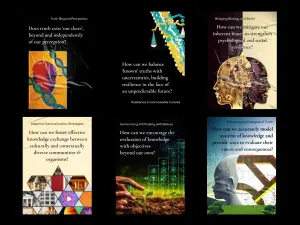
Wicked problems such as designing for Truth involve a multitude of hierarchically-nested, deeply interconnected dynamic systems. Our interactions with them cannot 'solve' inherent problems, but only change the challenges which are present. Given this complexity and our computational limits, any approach to influence the system must take a particular stance—an ethos and strategic perspective—from which to map the domains and identify and evaluate different leverage points, vectors/directions and potential approaches to problems within the system.
Truth is a complex idea in and of itself. Given that it is bound by what we can perceive, we can only ever have a probabilistic sense of any thing’s certainty by its evaluation against previous experience, recorded/communicated knowledge and our beliefs.
Given the Grand Challenge’s objective—design for safety—we identified ecosystem health as the best arbiter of Truth's value, making it our overarching strategic objective and stance by which to model Truth's underlying components.
We therefore mapped the concept of Truth across its cultural, biological, physical and metaphysical domains to create a general overview. This systems map highlighted the cultural domain as a critical area for designers to intervene, amplifying or mitigating certain bits of information by influencing how it is perceived, communicated and learnt about, analysed and understood.
At the individual level, this corresponded to 3 key leverage points by which we can influence judgments of Truth in society:
- Aesthetics (the symbolic)
- Comprehension (data and analysis)
- Communication (interpersonal transfer)
In order to recognise the fundamentally phenomenological and
therefore normative (ie., subject to human evaluation) nature of
Truth (as a constructed phenomenon within our embodied minds) we
provided a range of questions to encourage individual critical
reflection and re-evaluation of the overarching strategic
incentives behind ‘Designing for Truth’ as well as the
underlying mechanisms and intervention points by which design
can influence it.
Our systemic analysis and domain-specific evaluation highlighted key mechanisms humans use to construct and assess truth. This reveals a number of key leverage points and pathways (or vectors) for designers to intervene in the Truth ecosystem. These provide a range of strategic approaches and critical questions for exploring how to design for this deeply complex issue — not just for human societies but for our world and life as a whole.
With thanks to Keer Wei for her wonderful perspectives and great collaboration and to Laura Ferrarello, Ashley Hall, Craig Bremner, Fernando Galdon and Rute Fiadero for inspiration, critique and advice.
